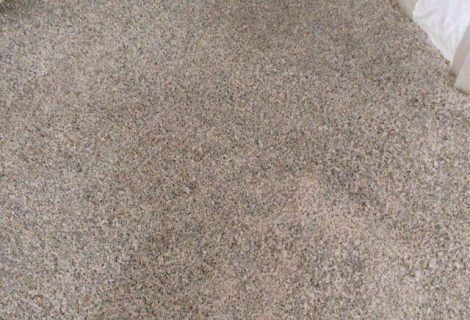KAB SEALING BAND
Sealing band
The type Kab sealing band with swell profile is a fusion of advantages of two different sealing materials for day joints. It utilises the advantages of sealing bands and swell materials. The structure of the type Kab band is reminiscent of a single arm of day joint seal tape with a round swell profile embedded in the lower part of the band.
A decisive advantage of the type Kab seal bands with swell profile is the option of installing them on the top reinforcement lattice of foundation slabs and footing without interference in the course and shape of the bars.Such a structure of the Kab bands prevents free flow of water in the swelling part by causing a pressure of the swell profile, and ensures at the same time a seal of the wall in the area of the ribbed arm.
GENERAL INFORMATION
Product description
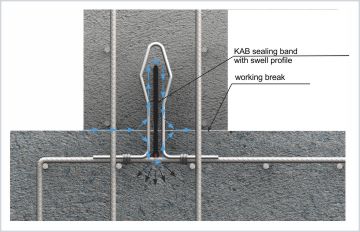 |
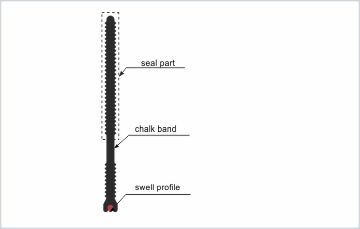 |
The type Kab sealing band with swell profile is a fusion of advantages of two different sealing materials for day joints. It utilises the advantages of sealing bands and swell materials. The structure of the type Kab band is reminiscent of a single arm of day joint seal tape with a round swell profile embedded in the lower part of the band.
Such a structure of the Kab bands prevents free flow of water in the swelling part by causing a pressure of the swell profile, and ensures at the same time a seal of the wall in the area of the ribbed arm.
| Property | Unit |
Requirements |
Tested per |
| External form | – | No cracks, rifts | Visual evaluation |
| Shore hardness | ˚Sh | 83±5 | PN-EN ISO 868:2005 |
| Stretch resistance | MPa | ≥ 8 | PN-EN ISO 527-2:1998 |
| Relative elongation at break | % | ≥ 200 | PN-EN ISO 527-2:1998 |
| Shear resistance | N/mm | ≥ 12 | PN- ISO 34-1:2007 |
| Low temperature behaviour, -20 ˚C, relative elongation at break |
% | ≥100 | PN-EN ISO 527-2:1998 |
Usage
Seal bands with swell profiles, of type Kab 125 and type Kab 150 are used to protect concreting day joints at the intersection of bottom slabs and walls. These bands may be concreted already during the first phase of concreting work at a depth of 30-50 mm. This allows the cover of the top slab reinforcement as housing for the band, and does not require intervention in the shape and course, in a protected structure, of the reinforcement bars. This also eliminates the necessity of having to make an interlock in the slab for the purpose of embedding the band.
Limiting subsequent actions related to embedding the band at the intersection between slab and wall are a clear time-saving measure that allows one to reduce the cost of work related to the usage of additional installation materials. In order to maintain proper embedding in the concrete at the first stage of concreting of type Kab bands, a chalk band is useful, in the form of a flat band running along its axis.
Such bands have been for years successfully used in sewage treatment plants, swimming pools, liquid tanks and in residential housing. Kab bands should be used when these structures are under load by liquids with maximum hydrostatic pressure not exceeding 0,2 MPa.
Storage
The band must be stored in cardboard boxes as delivered by the manufacturer. They should be placed on a pallet, on a stable surface, protecting them from tipping over. Due to the characteristics of the utilised material, including swelling in humid conditions, they have to be stored in a cool and dry place.

| Kab sealing band |
||||||
| Symbol |
h [mm] |
a [mm] |
Package box/pallete [mb/pcs.] |
Sales unit |
||
Weight
[kg/mb]
Art. no.
Type Kab 125 seal band with swell profile1255÷625/8box1,05SU-TU-KB-0-02354Type Kab 150 seal band with swell profile1505÷625/8box1,20SU-TU-KB-0-02356Type KS 125 assembly rail125—0,16SU-TU-KB-0-02351Type KS 150 assembly rail150—0,23SU-TU-KB-0-02352Type VSB installation clamp150—0,10SU-TU-KB-0-02349



INSTALLATION
The mounting shackles must be joined permanently with mounting wire to the slab rebar. After concreting of the bottom slab, the type Kab seal band with swell profile is embedded within concrete at a depth of approx. 30-50 mm. The concrete mix that may at that time cause unevenness or flaws, needs to be evened out. The part of the band protruding outside of the slab surface outline needs to be concreted within the wall in the second phase of concreting work.
A decisive advantage of using type Kab seal bands with swell profile is their size and weight. They take up little space during storage, and their low weight facilitates quick and easy installation. The flexible material, of which they are made, allows one to protect designed structures having circular form or various wall arrangements. At corners of buildings where Kab bands were used, the person unfurling the band must provide it with the shape that the wall takes, through appropriate bending.
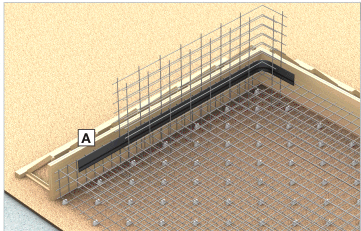 |
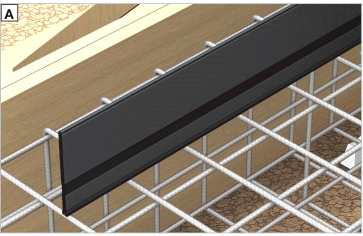 |
| Step 1. Layout of the band on the reinforcement lattice. | |
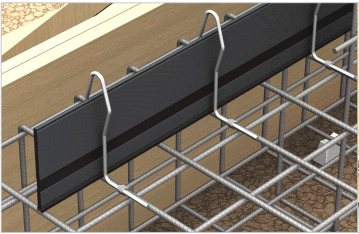 |
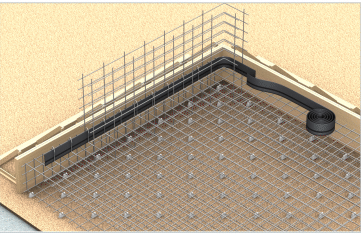 |
| Step 2. Attachment of assembly clamps. | Step 3. Band joining. |
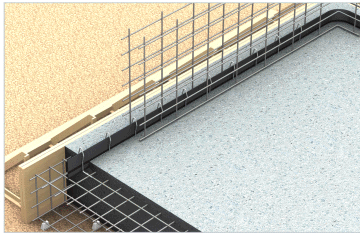 |
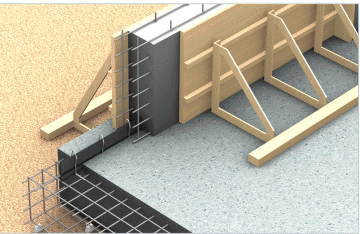 |
| Step 4. Foundation slab concreting. | Step 5. Wall concreting. |
Joining bands
In work conditions of installation of Kab bands at the construction site, it often becomes necessary to join subsequent band segments. This can be done in two ways:
by using type KS system assembly rails,
by welding, using a small welder’s axe or a hot air blower.
Joining bands using type KS assembly rails can be done at any construction site and in any atmospheric conditions allowing normal work. The rail, specially designed for assembly work, is a set of components joined together by screws. The component is made up of two flat compression profiles and three bands of swell material joined by screws with wing nuts.
Before a joint is made, one has to make openings in the ends of the band rolls to be joined, either by a centre punch or by drilling. One can use, during this, a metal flat profile as a matrix to position the holes appropriately. The ready joint is a layered component made of the type Kab band and bands of swell materials between them, and flat profiles on the outside (see figure below).
More experienced installation specialists may join bands by welding using electric welders. Before the type Kab seal band ends are gently melted a bit, the swell profile needs to be extended a bit out of the lower band end. After the ends of the rolls to be joined are heated, until the flexible material flows out at the axe’s edge, they must be pressed on one another.
After making such a joint, the swell component must be put in its place. A different method of welding seal bands with swell profiles is executing overlay joints with at least 5 cm in length. During this operation, one has to take care to precisely melt and join together the ribbed band sections.

| Joining bands using an assembly rail | Joining bands by welding an overlay section |

